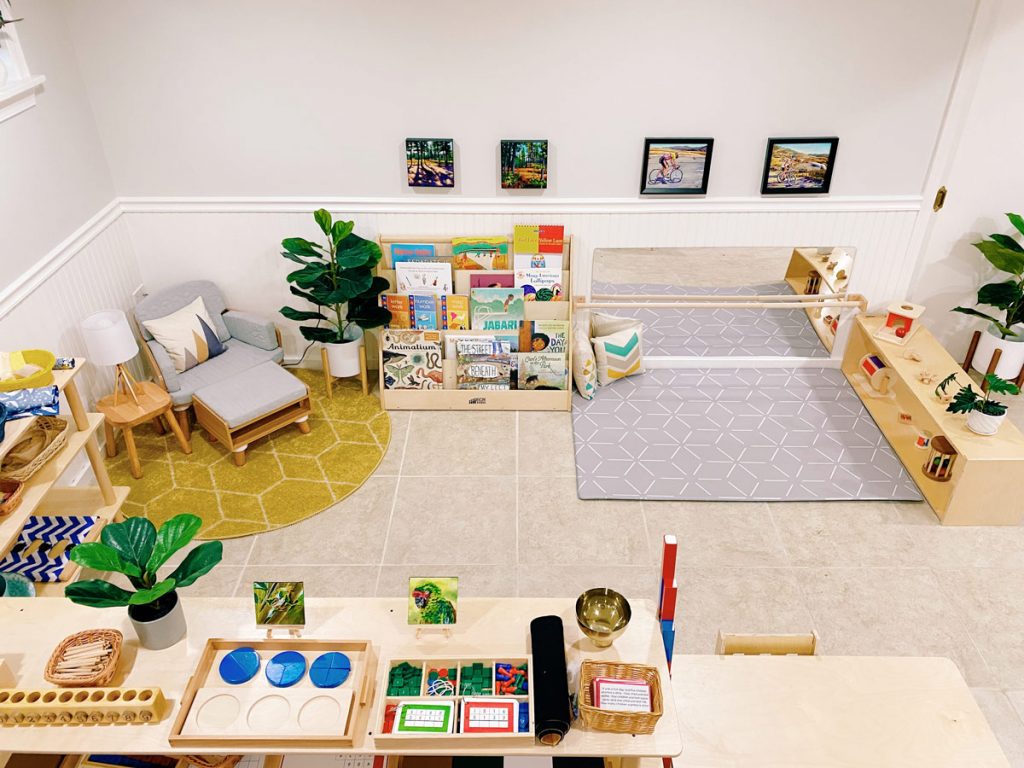As both Montessori and homeschooling are becoming increasingly popular teaching methods, it’s no wonder that some parents want to combine the two education options. Many parents have been able to successfully integrate Montessori into their homeschooling, but how do you get started?
To start Montessori homeschooling, carefully consider and organize the learning environment, prepare opportunities for the child to spend time with children and adults of all ages, remove extrinsic motivations, and research different Montessori curriculum materials that can guide learning.
Starting Montessori teaching can be overwhelming, but there are plenty of resources to help you figure out how and where to start with your child(ren). If this is something you want to pursue, we’ll help you get started!

Can You Do Montessori in Homeschooling?
It is absolutely possible to homeschool with Montessori! Although it was designed for group classrooms, many of the principles behind Montessori are closely aligned to those of homeschooling. One of the reasons that founder Dr. Maria Montessori started this teaching method was to provide customizable education for each child.
And where is a better place to create a customized learning plan than at home with your own child?
How Do I Start Montessori Homeschooling?
Carefully Consider and Organize The Learning Environment
To succeed, Dr. Montessori has found that children need organized, simple, logical, and accessible learning environments. The best way to create such a space in your own home is to look through the house and envision everything from your child’s perspective. Look for accessible places to put books, educational toys, or various other items that inspire learning. Think about what materials would catch your child’s attention and where the best places for them would be.
After imagining what your child will see and experience, begin uncluttering the low shelves and areas that are accessible to the child. Start arranging individual learning items in each place and hang interesting art or diagrams within the child’s eye level. For the learning items, consider placing them on small trays for the child to be able to pick up, use, and easily return to its designated place.
In addition to organizing learning items around the house, consider what other furniture or decorations can foster a focused and supportive learning environment. For example, place small rugs near areas that have multiple learning items to encourage the child to play with and investigate the items on the floor. Or, another common Montessori activity is to put fresh flowers in small vases in learning spaces to encourage interest in nature and brighten up the space.
Once the child has begun interacting with your organized learning environment, you’ll need to keep the environment from getting cluttered, disorganized, and/or confusing. Emphasize only working on one activity at a time. You can help your child do this by encouraging them to put one activity away in its designated spot as soon as they are done with it. By consistently maintaining each learning item or activity’s spot and enforcing only one activity at a time, the child will be able to appreciate and maintain the learning environment along with you.

Prepare Opportunities for The Child to Spend Time with Children and Adults of All Ages
One of the important characteristics of Montessori is having mixed-age classrooms. The idea is that by allowing children to engage with different age groups, they can learn from each other and learn how to effectively collaborate and cooperate with others.
Providing opportunities for mixed-age learning is still applicable to Montessori homeschooling. First, it can address the common concern of homeschooled children not getting enough socialization. Second, Montessori is all about introducing children to real-world learning and experiences. By allowing children to associate with and learn alongside other curious and productive individuals of various ages, you are fostering opportunities for the children to have experiences that more closely mirror what they will experience throughout life.
This can also promote healthy relationships between children and adults. If a child can have secure interactions with various adults who are engaged in the child’s learning interests, they will be more likely to grow up feeling comfortable accepting adult advice and will be able to express their independence in a healthy and productive manner.
Remove Extrinsic Motivations
In traditional classrooms, extrinsic motivators are things such as receiving grades, getting gold stars, the threat of detention or extra homework, and the possibility of getting more free time in class. Extrinsic motivators can be positive or negative, but the common factor between them is that they are all something outside of the child that is motivating them to behave in a certain way. The opposite, then, is intrinsic motivation.
Intrinsic motivation comes from the child. Within everyone is a natural desire or interest to do certain things and to learn. Montessori teaching demands that the teacher or parent protects and nourishes the child’s natural interests in learning. This means not forcing the child to learn something that they have no interest in, not judging what they want to learn, not interrupting the child’s learning or activities, and not giving praise or applauding the child for having taken an interest in something. Every time your child expresses or doesn’t express interest in learning something, you should treat their desires as natural and avoid labeling them as either good or bad.
The focus should be on experiences and guiding your child to make the most of an experience. Promoting experiences and refraining from judging those experiences will show your child that there are no expectations for them. This makes them free to learn for learning’s sake, not yours or anybody else’s.

Research Different Montessori Curriculum Materials That Can Guide Learning
As stated before, Montessori does not have a set curriculum. What is taught should be initiated by the child and everything should be customized to that child’s needs and interests. That being said, different Montessori curriculum materials have been made to create opportunities for the child to express interest in and learn about various things.
These materials are essentially packages of learning activities for the child. And when presented with learning activities, children naturally express curiosity and interest in the materials. Thus, these materials are a way for you to guide your child so that they will naturally want to learn about reading, writing, math, history, geography, science, etc.
What Makes Montessori Homeschooling Better Than Other Methods of Homeschooling?
The child-centered focus on Montessori Homeschooling is what truly sets it apart. Within Montessori, children are encouraged to study and learn about what interests them at their own pace. There isn’t a set schedule that forces the child to move onto other activities before they are ready or to continue to do something that they are ready to move on from. This creates the freedom and independence that makes Montessori so exceptional.
The children taught with Montessori homeschooling are better able to self-monitor and self-discipline since they are the ones pacing and directing their learning. They become active participants in learning, and as stated previously, this creates an intrinsic motivation to keep learning. The child will get their own motivation and internal reward for learning and progressing which ultimately reduces the risk of student burnout.
Since Montessori homeschooling is intrinsically motivated, there are no tests, quizzes, or exams for the child. This further encourages independence and self-discipline but also reduces unnecessary stress children experience in relation to traditional teaching methods. Removing these factors makes it more likely that the child will want to continue learning and enjoy the process.
Additionally, Montessori homeschooling is not just focused on teaching academics. It has more of a focus on holistic living skills. It promotes learning practical academic, social, and life skills and not just skills that everyone “should” know for the sake of knowing them. Part of this is the encouragement of mixed-age learning. The collaborative skills taught by working with other children or adults of different ages are transferable to various real-world experiences and increase the social maturity of the child.

